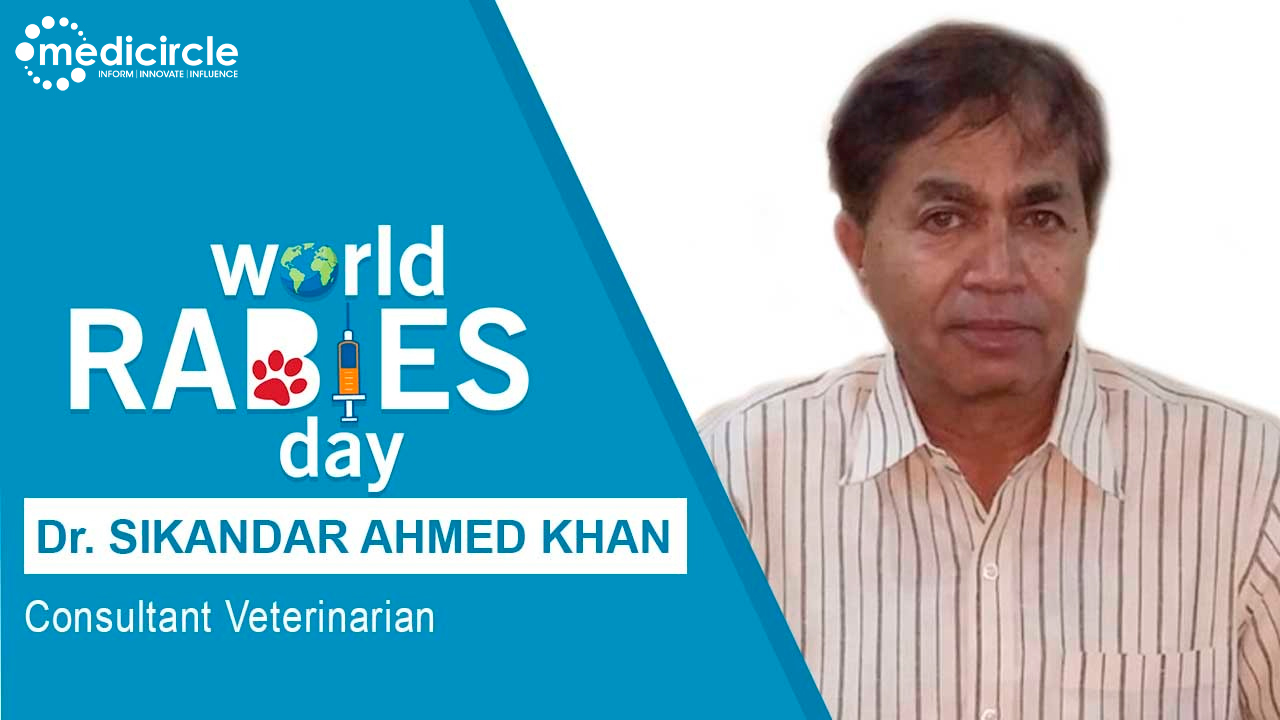World Rabies Day is observed worldwide to mark the death anniversary of Louis Pasteur, the French chemist, and microbiologist, who developed the first rabies vaccine. To celebrate this milestone, this year’s theme focuses on facts about rabies and dispelling any myths or misconceptions. While rabies is a 100% preventable disease, more than 59,000 people die from the disease around the world each year. In India, rabies is a major public health problem that kills 20,000 people annually. The disease is endemic throughout the country with the exception of the Andaman and Nicobar Islands and Lakshadweep islands. On the occasion of World Rabies Day which is on 28th September, we at Medicircle, are conducting an exclusive awareness series wherein we will be featuring experts of this field to understand and create awareness about rabies and how to effectively cure it.
Dr. Sikandar Ahmed Khan is working as a Veterinarian and Consultant in the fields of Pets, Large Animals, Small animals in Hyderabad, Telangana state. He has surgical skills in caesarian, major, and minor surgeries. He has also worked abroad in the field of Dairy farms having a capacity of 20 thousand animals in Saudi Arabia. He is running an Animal clinic, Online Video Consultation & Animal Mobile Clinic in Hyderabad.
About Rabies
Dr Khan begins, “Rabies is a viral and zoonotic disorder. Meaning it is a disease that can be transferred from animals to humans. Unfortunately, rabies is a fatal disease. A bite from a rabies dog or cat can transfer the infection to another animal or human. The disease particularly affects the brain and the nervous system. The infection enters from the blood and travels to the nerves to the spinal cord and finally reaches the brain. In the brain, it multiplies. After the multiplication, the virus finds its way into the salivary glands. This is why the dog’s bite can spread the virus. Rabies is also labelled as Madness in Dogs. Since the virus affects the brain, the animal doesn’t know what he is doing.”
How common is Rabies?
He answers, “Rabies is spread in more than 150 countries. But the disease is more prevalent in Asia and Africa. The first reason behind this is that these two continents have a higher dog population. Secondly, the awareness and literacy regarding this disease is very less. Rural areas have more rabies cases compared to urban areas. If compared between children and adults, the former observes more cases. The age group between 5 to 14 is unaware if the dog has rabies or not and once scared they tend to run. This makes the dog chase and bites them.”
How to prevent Rabies?
He explains, “Rabies is highly preventable. The WHO is aiming to eradicate rabies just like polio and smallpox. For this, they are conducting many awareness programs. A 100% preventable vaccination should be done on dogs. More importantly, people should be aware of how to recognize a rabies-infected dog. Once you know how to recognize the rabies dog or cat, avoid them and avoid getting infected too. Globally 59,000 deaths and 20,000 death in India could be avoided if people only had the awareness."
How dealy is a rabies bite?
Dr says, “People think ‘I got cured after the bite, so all is okay.’ This is a wrong mindset. If one gets bitten by a rabies-infected dog or cat, then if not treated immediately it can turn fatal. There’s a 100% chance of death. After getting bitten, a person can see the symptoms within a month or three. It can even stretch to a year. One must not wait for the symptoms to show themselves. The treatment should be sought immediately. Once the symptoms show themselves, it is then that the disease turns 100% fatal.”
First Aid after bite
Dr mentions. “A first aid is not the same as treatment. When a dog or a cat bites, there could be a serious injury or a simple scratch. Blood could come out of your wound or it could not. Irrespective of the condition of your wound, give it a thorough wash. Leave the wound under a running tap for 10-15 minutes. Our aim behind this is to remove the virus from deeply entering our body. If you have a povidone-iodine solution then use that. After this make sure you visit a doctor. Then a curative vaccination course of 5 to 6 injections should be taken as prescribed by your doctor.”
(Edited by Priyal Shah)

 Rabies is a preventable disease only if one follows the advice of veterinarian, Dr Sikandar Ahmed Khan. Know what precautions and first aid one needs to take after getting bitten by a rabies dog or cat.
Rabies is a preventable disease only if one follows the advice of veterinarian, Dr Sikandar Ahmed Khan. Know what precautions and first aid one needs to take after getting bitten by a rabies dog or cat.




.jpeg)
.jpeg)

.jpeg)
.jpeg)

.jpeg)

_(1)_(1)_(1).jpeg)
.jpeg)





.jpeg)

.jpeg)

.jpeg)
.jpeg)
_(1).jpeg)
.jpeg)




